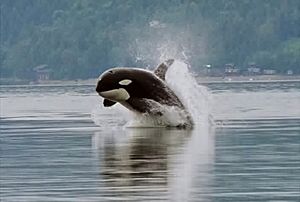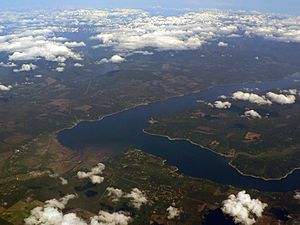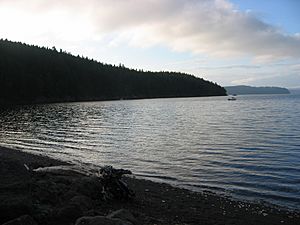Hood Canal facts for kids
Hood Canal is a long, narrow arm of the sea, like a deep inlet, located in Washington State, USA. It's a natural waterway, not a man-made "canal." It's also part of the larger Salish Sea, which includes many waterways around Washington and Canada.
Contents
What is Hood Canal Like?
Hood Canal is quite long, stretching about 50 miles (80 km) southwest from its entrance. It's usually about 1.5 miles (2.4 km) wide. The water is fairly deep, averaging about 176 feet (53.8 meters).
It has a unique shape! Near a town called Union, it makes a sharp turn to the northeast. This bend is known as "The Great Bend." The canal then continues for about 15 miles (24 km) to Belfair, where it ends in a shallow area called Lynch Cove.
Hood Canal acts like a natural border, separating the Kitsap Peninsula from the Olympic Peninsula in Washington. The United States Navy has a base, Naval Base Kitsap, on the eastern side of Hood Canal near Silverdale.
There are also smaller bays within Hood Canal. The biggest is Dabob Bay, which the Navy uses for its submarines. Quilcene Bay is another inlet. Near the northern end, you'll find Port Gamble, both a bay and a town.
Many rivers flow into Hood Canal, mostly from the Olympic Peninsula. These include the Skokomish, Hamma Hamma, Duckabush, Dosewallips, and Big Quilcene Rivers. Smaller rivers like the Union, Tahuya, and Dewatto Rivers flow in from the Kitsap Peninsula.
How Hood Canal Was Formed

Hood Canal and the rest of Puget Sound were created a very long time ago, about 13,000 years ago! Giant sheets of ice, called glaciers, moved across the land during the last Ice Age. As these glaciers slowly moved, they carved out the deep valleys that filled with water when the ice melted, forming Hood Canal.
A Bit of History
The name "Hood Canal" was given by a British Navy captain named George Vancouver on May 13, 1792. He named it after Admiral Lord Samuel Hood. Captain Vancouver first called it "Hood's Channel," but later wrote "Hood's Canal" on his maps. The official name "Hood Canal" was decided in 1932.
Roads and Bridges
If you drive along the west side of Hood Canal, you'll be on U.S. Route 101.
A very special bridge crosses Hood Canal: the Hood Canal Bridge. It's a floating bridge, meaning it floats on the water! It's one of the longest floating bridges in the world, stretching about 6,521 feet (1,988 meters). This bridge is unique because it's built on saltwater and can handle big tides.
Fun Things to Do at Hood Canal
Hood Canal is a great place for outdoor activities! There are several state parks along its shores, including Belfair, Twanoh, Potlatch, Triton Cove, Scenic Beach, Dosewallips, and Kitsap Memorial.
Popular activities include:
- Swimming in the cool waters.
- Boating and exploring the different bays.
- Fishing for various types of fish.
- Gathering shellfish like clams and oysters.
The Theler Wetlands in Belfair offer trails where you can see marsh birds and plants. Many small towns along Hood Canal, especially on the western side, are close to hiking trails in the Olympic National Forest and Olympic National Park. Places like Staircase Campground and Hama Hama Recreation Area are popular starting points for hikes through beautiful, green forests.
Low Oxygen Levels: A Challenge for Hood Canal
Sometimes, Hood Canal faces a big problem: low oxygen levels in the water. This is like when you can't breathe well. When oxygen levels drop too low, it creates a "dead zone" where many fish and other marine animals can't survive.
Why Does Oxygen Get Low?
One main reason is something called "algal blooms." Algae are tiny plants that grow in the water. If there are too many nutrients in the water, like from fertilizers used on farms or from leaky septic systems (which handle wastewater from homes), these algae can grow out of control.
When these huge amounts of algae die, tiny bacteria eat them. As the bacteria eat, they use up a lot of the oxygen in the water. This process is called eutrophication. Warm weather and slow water movement in the southern part of the canal can make this problem worse.
Sometimes, low oxygen is also part of natural cycles, but human activities can make it much worse. For example, a change in wind direction can stop fresh, oxygen-rich water from entering the canal.
What Happens When Oxygen is Low?
When oxygen levels are very low, it's called hypoxia. This harms marine life. For example, valuable seafood like geoduck clams and Dungeness crab can be affected. There have been times when many fish and shrimp have died and washed up on the shore because the water had almost no oxygen.
Eelgrass beds, which are important nurseries for young salmon and crab, have also decreased in Hood Canal. Even bottom-dwelling fish like rockfish are struggling because their habitats are disappearing.
What's Being Done to Help?
Many groups are working together to fix this problem. The Hood Canal Dissolved Oxygen Program (HCDOP) is a partnership of many organizations. They work with local governments and tribes to find ways to bring back healthy oxygen levels for marine life. They study the water, model how things work, and look for solutions.
Some ideas to help include:
- Improving sewage systems: Making sure septic tanks don't leak and building better sewage treatment plants can stop too many nutrients from entering the water.
- Restoring wetlands: Wetlands are like natural filters. Restoring them along Hood Canal can help clean the water before it flows into the canal.
- Restoring native plants: Planting native plants that don't add too much nitrogen to the soil can also help.
It's a big challenge, but many people are working hard to protect Hood Canal and its amazing wildlife!
Icing Over
In December 2009, during a very cold week, parts of Hood Canal actually froze over with a thin layer of ice, especially near the shore. This is quite rare for this area!




